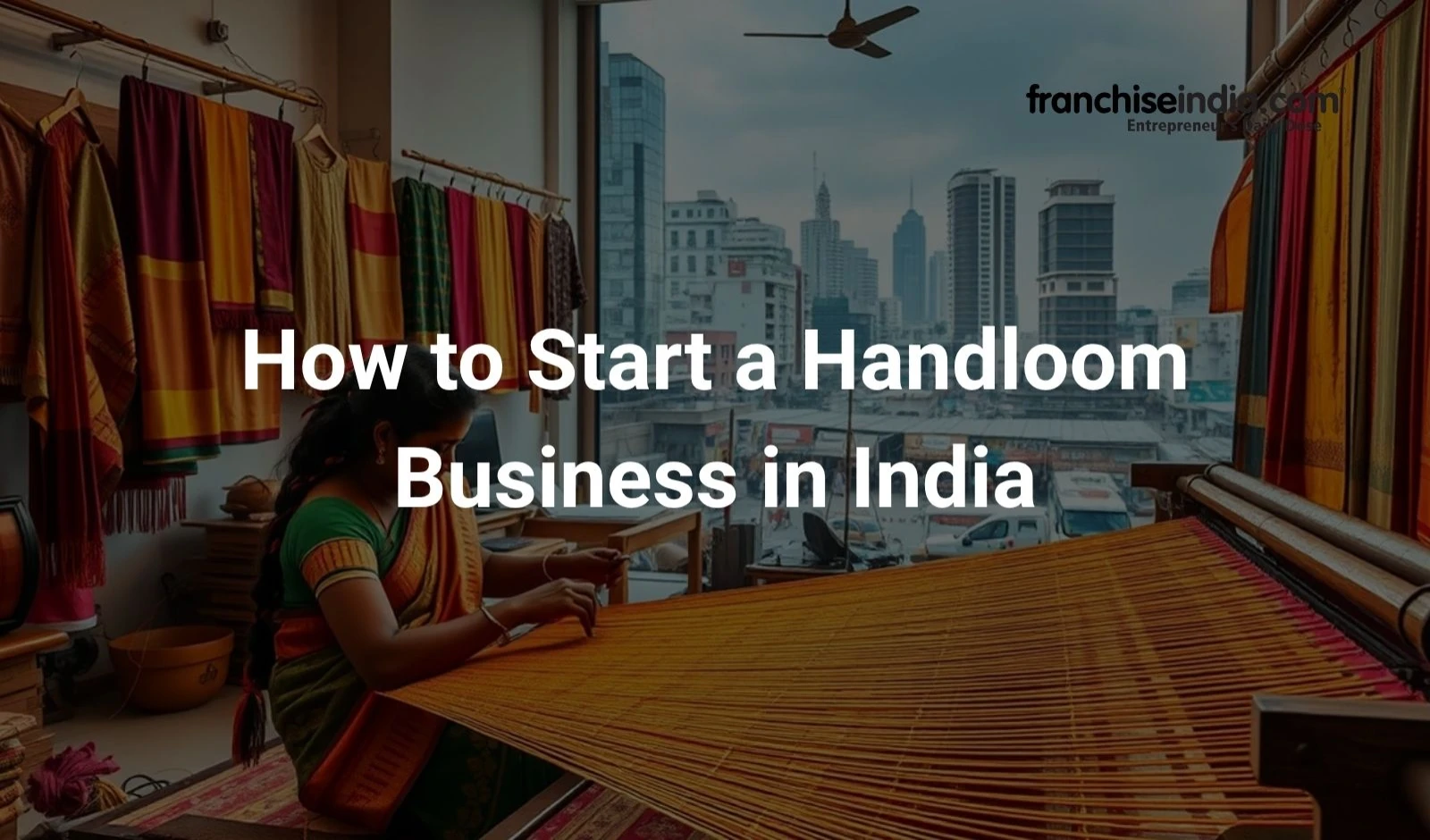
Starting a handloom business in India means bringing together age-old skills and a fresh, practical approach. India has an incredible weaving tradition, and more people now want handmade, eco-friendly fabrics; that’s a great opening for anyone ready to jump in. You don’t have to go big right away—start small by teaming up with local weavers or setting up a handful of looms. You can get going with as little as ₹75,000, but if you want to scale up, you might need up to ₹25 lakh. Register your business under Udyam (MSME), hunt down good-quality yarn and dyes, and find skilled artisans to work with you. The government actually offers a lot of support, you can check out schemes like the National Handloom Development Programme (NHDP), PMEGP, and MUDRA loans—they can make a real difference. Get on e-commerce sites, show up at craft fairs, and use social media to get your products in front of more people. If you focus on authentic design, solid quality, and sustainable methods, your business can do well. You’ll also help keep traditional skills alive and build a brand people trust in India’s growing handmade market.
In this article we are going to cover how to start a handloom business in India along with the investment required and risks that come with it.
Also read: How to Start a Jute Clothing Business in India
How to start a handloom business?
1. Understand the market and decide your model
 (1).jpg)
The business model you choose shapes everything—costs, profits, and even how you spend your day. If you want to keep it simple, there’s the cottage model, with just a handful of weavers—anywhere from one to five—you can make small batches for local buyers or sell online. This model needs less money upfront and lets you grow at your own pace. Go for a small manufacturing unit or cluster with five to fifty looms. It’s more expensive, but you get better control over quality and can handle bigger orders for boutiques or even companies. You could also focus on curating and selling products from lots of weavers—think of it as building a brand or aggregator, where your main job is design, marketing, and distribution. And if you’re aiming high, there’s the export route. That means working with bulk international buyers, meeting strict standards, and getting an Import-Export Code (IEC). With more people looking for sustainable and ethnic fabrics—like sarees, dupattas, ikat, jamdani, and khadi—handloom is a business that can really grow.
2. Rough startup cost estimates
 (2).jpg)
Costs vary with scale and technology. Below are typical starting scenarios.
A. Home-based / micro (1–3 looms)
- Manual table or pit looms cost ₹15,000–₹40,000 each, while yarn, dyes, and other raw materials add ₹10,000–₹30,000.
- Basic accessories like shuttles and warping boards cost around ₹5,000–₹10,000.
- For packaging, photography, website setup, and initial marketing, allocate ₹15,000–₹40,000, plus ₹30,000–₹70,000 for three months of working capital.
- Overall investment ranges between ₹75,000 and ₹2 lakh.
B. Small workshop (5–20 looms)
- Semi-automatic looms cost ₹30,000–₹1 lakh each.
- Expenses for workspace setup, raw materials, dyeing, and labor (₹8,000–₹20,000 per weaver monthly) bring the total setup and three-month operational cost to ₹5 lakh–₹25 lakh.
- These ranges reflect typical Indian prices for manual handlooms and small production equipment — you can buy simpler looms for ₹10–30k or heavier production looms at ₹50–1,00k or more depending on make and automation.
3. Funding & subsidy options (where to look)
 (3).jpg)
The Government of India offers several financial and development schemes to support handloom entrepreneurs, which can be combined with bank loans and microfinance for easier funding. The National Handloom Development Programme (NHDP) helps fund clusters, design ideas, marketing, and even training. If you’re looking for working capital, check out the Weaver’s Credit Card and MUDRA loans. They offer anywhere from ₹50,000 to ₹2,00,000 for individuals, and even more for larger groups—with low interest and margin money support. The Pradhan Mantri MUDRA Yojana (PMMY) splits loans into three categories—Shishu (up to ₹50,000), Kishor (₹50,001–₹5 lakh), and Tarun (₹5–₹10 lakh)—so you can find what fits your needs. PMEGP is another option if you’re setting up a bigger unit, offering subsidies that lighten the load. You can apply for NHDP help through your state handloom directorate, visit your local bank for loans, and check with your district KVIC office for PMEGP support. All these programs make it a lot easier to find the money and grow your handloom business.
4. Legal & registration checklist (low cost)
 (4).jpg)
- Business registration: A sole proprietorship can start with minimal fuss; for scale, consider Pvt Ltd or LLP (cost varies).
- Udyam/MSME registration—free, useful to access government benefits, subsidies, and tenders. (Udyam registration is online and free.)
- GST registration—required if turnover crosses threshold (or to claim input credit / B2B sales). Learn GST slabs relevant to textiles.
- IEC (Importer-Exporter Code)—mandatory if you plan to export. Generally applied via the DGFT portal (process available online). (There’s an online application process via DGFT; check the latest nominal fees/process).
- Bank accounts and bookkeeping—open a current account in the business name and maintain basic books (cashbook, bank book, and purchase & sales registers).
- Intellectual property—register your brand/trademark (MSME schemes sometimes subsidize 50% of registration fees).
5. Production planning: looms, raw materials, skills
 (5).jpg)
Selecting the right equipment and materials is key to starting a successful handloom business. You’ll need to pick between pit, frame, table, or semi-automatic looms, based on how much you want to produce and how much you can spend. Basic pit or table looms cost between ₹15,000 and ₹40,000, while the advanced ones are pricier. Always buy from suppliers you trust—don’t forget to budget for delivery and installation. For materials, go for top-quality cotton, silk, or wool yarn, and keep a steady supply of dyes, sizing agents, and finishing chemicals.
Building a good relationship with your yarn suppliers helps you get better deals and reliable stock. When you’re ready to launch, make 10–20 prototypes of your main products—maybe sarees, stoles, or cushion covers. Set aside ₹10,000–₹50,000 for this stage to make sure your samples stand out. Don’t skimp on training and quality control, and teach your weavers new techniques, keep an eye out for defects, and make sure your workspace is safe. State handloom directorates, especially through NHDP, often offer great support and training, so take advantage of that whenever you can.
Also read: How to Start a Women's Clothing Business in India
6. Pricing, margins & break-even
 (6).jpg)
Pricing in the handloom business depends on several factors, including material costs, labor effort, craftsmanship value, and distribution expenses. You’ll spend anywhere from ₹200 to ₹500 on materials and dyes, and labor costs can run between ₹300 and ₹1,000, depending on how intricate the weave is. Throw in another ₹150 to ₹400 for packaging, shipping, and commissions, and you’re looking at a total manufacturing cost of around ₹650 to ₹1,900 per piece.
When you sell to retailers, the wholesale price usually lands at about 1.2 to 1.6 times your production cost. But if you’re selling directly to customers—maybe through your own website or social media—you can price it at 2.5 to 4 times what it cost you to make, especially if your brand has a strong story or reputation. Most brands shoot for a gross margin of 35–55%, while retailers aim for a 30–40% markup. And the more complex the weave—like jamdani or jamawar—the higher you can reasonably price it. These pieces take extra time and skill, so the price should reflect that and help keep the craft alive.
7. Sales channels & marketing
 (7).jpg)
A successful handloom business should use multiple sales channels to balance profit margins and sales volume. Selling directly to customers gives you better margins, but you’ll spend more on advertising and creating content to get noticed. Listing your products on Amazon, Flipkart, or niche marketplaces like Jaypore or IndiaCrafts widens your reach and can boost sales, though they’ll take an 8–20% commission. Supplying to wholesalers and boutiques means bigger, consistent orders, but the per-piece profit shrinks. Don’t skip craft fairs and exhibitions, either—they’re great for building your brand and meeting new buyers, especially with support from the NHDP and state handloom departments. Planning to export or sell B2B? You’ll need solid quality control, standard packaging, and an Import-Export Code (IEC).
8. Quality, certification & traceability
 (8).jpg)
The Handloom Mark, issued by the Textiles Committee, certifies genuine handwoven products and boosts retail and export credibility. If you produce GI-certified crafts like Banarasi or Pochampally, highlight that, as it signals authenticity. Stay sharp on finishing—wash, size, and iron everything properly. Set clear quality standards and stick to them to avoid returns and keep customers happy.
9. Common pitfalls and how to avoid them
 (9).jpg)
Avoid common mistakes in the handloom business by valuing skilled labor with fair wages and pricing that reflects craftsmanship. Check quality before shipping anything out—returns hurt both your wallet and your reputation. Grow at a steady pace, keeping an eye on demand, and make sure your GST and Udyam registrations are up to date so you can tap into government support and avoid legal headaches.
10. Scaling and growth levers
 (10).jpg)
To scale a handloom business, focus on strategic collaborations and value enhancement. Build design partnerships with fashion designers to create exclusive collections that command premium prices. Partner with designers to create limited-edition lines that people will pay more for. Bring weavers together in clusters to handle big orders; programs like the NHDP offer grants for training and equipment. For international expansion, get your IEC and look for boutique buyers abroad who appreciate handmade, authentic textiles. You can also offer extras like natural dyeing, hand embroidery, or small-batch collections to make your brand stand out.
Final thoughts
Starting a handloom business in India isn’t just about making money—it’s a chance to keep a rich tradition alive. There’s a growing appetite for eco-friendly, handmade textiles, so you can build something meaningful and profitable. The real key is to understand the craft, never compromise on quality, and always take care of your weavers. Start small—maybe work with a handful of artisans or set up a couple of looms—then build your presence online and at local fairs. Tap into government schemes like NHDP, PMEGP, and MUDRA loans for funding, and get the Handloom Mark to build trust. Tell your story, stay authentic, and keep innovating with your designs. Blend tradition with smart marketing, and you’ll create a business that grows sustainably, supports rural jobs, and helps celebrate India’s textile heritage—earning respect and recognition at home and around the world.
You might also like: How to Start a Small Clothing Business from Home

